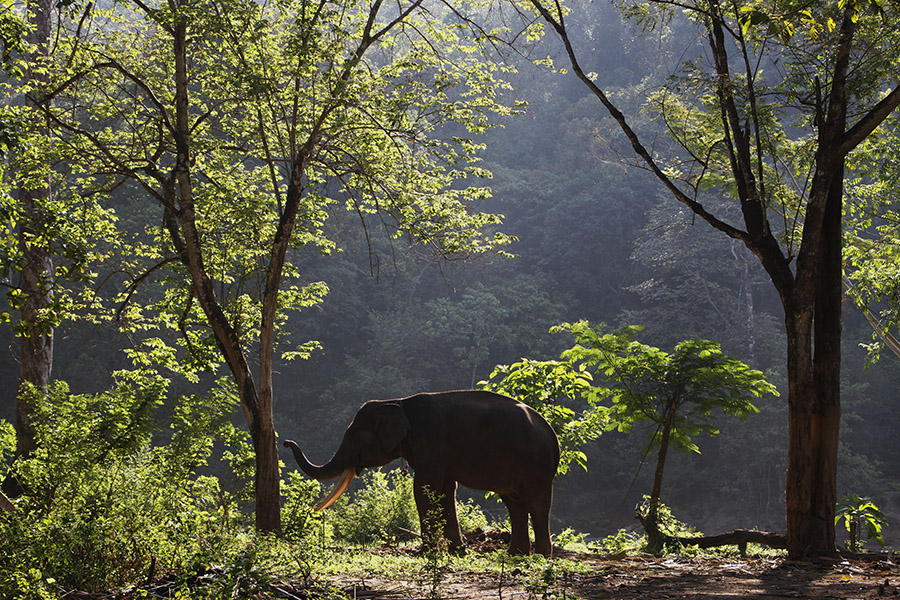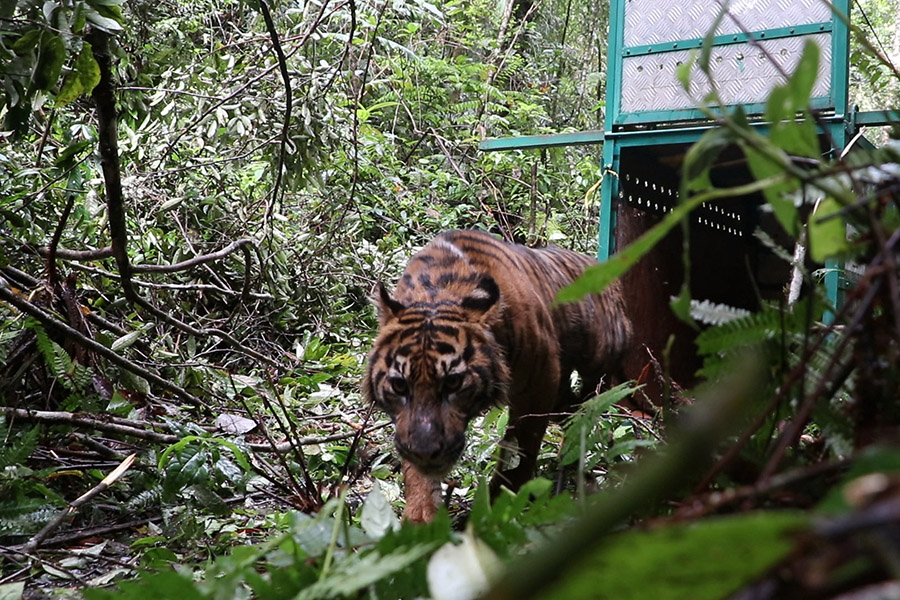A recent study sheds light on how wild animals in Asia have managed to survive and avoid extinction over the last 12,000 years. These animals include tigers, elephants, wild pigs, and clouded leopards.
Conducted by Zachary Amir, Jonathan H. Moore, and colleagues from the University of Queensland, the research titled "Megafauna Extinctions Produce Idiosyncratic Anthropocene Assemblages," published in the Science Advance Journal on October 21, 2022, Volume 8, Issue 42, indicates an increase in the population of these four species in areas with human infrastructure.
The researchers delved into paleontological records to compare the historical distribution of 14 largest species in Asia, such as tigers [Panthera tigris], sun bears [Helarctos malayanus], leopards [Panthera pardus], dholes [Cuon alpinus], and clouded leopards [Neofelis nebulosa].
They also studied nine other large species including Asian elephants [Elephas maximus], Sumatran rhinoceros [Dicerorhinus sumatrensis], gaurs [Bos gaurus], bantengs [Bos javanicus], tapirs [Tapirus indicus], sambar deer [Rusa unicolor], wild pigs [Sus barbatus], Sumatran serows [Capricornis sumatraensis], and wild boars [Sus scrofa].
"From fossil analysis, the drivers of megafauna extinction have shifted drastically between the Pleistocene period [between 2.6 million and 11,700 years ago], Holocene [11,700 to 100 years ago], and the Anthropocene era [less than 70 years from now]," wrote the researchers.

During the Pleistocene, geological, climatic, and biological processes operated slowly, such as fluctuations in sea levels, shaping extinction dynamics. During the Late Pleistocene and Early Holocene, there was a surge in megafauna extinction coinciding with human colonization and settlements combined with climate factors driving habitat availability.
The influence of humans on biodiversity patterns has increased over time, and since the mid-20th century [1950 onwards], a period now termed the Anthropocene, both direct and indirect human actions have become the primary drivers of species existence.
"Extinctions continue to occur today, with at least 322 terrestrial vertebrate extinctions since 1500," explained the researchers.
To document megafauna destruction and measure local megafauna abundance, the researchers conducted trap camera surveys in ten primary tropical forest landscapes in Sumatra, Kalimantan, Singapore, and Thailand.
Sampling in Sumatra took place in Gunung Leuser National Park, Kerinci Seblat National Park, and Bukit Barisan Selatan National Park. These three tropical forests are UNESCO Rainforest Reserves in Sumatra.
"All Sumatran landscapes have a mix of primary forests and some smaller forests logged more than 20 years ago, with moderate hunting levels."
Sampling in Kalimantan was conducted in Lambir Hills National Park, Malaysia, an area experiencing high hunting pressure.
In Singapore, sampling was done in the Central Catchment Nature Reserve and small offshore islands like Pulau Ubin. In Thailand, it was in the Khao Banthat Wildlife Sanctuary, a fragmented forest along low mountains near densely populated areas, and Khao Yai National Park, an intact primary forest linked to the Dong Phayayen-Khao Yai Forest Complex.

"All landscapes studied are part of the Sunda biogeographic subregion, except for Khao Yai National Park, which is located in the Indo-Malayan biogeographic subregion," wrote the researchers.
The study focused on Southeast Asia as this region, according to the researchers, is ideal for studying dynamic conservation threats, maintaining high megafauna diversity yet experiencing extreme deforestation and hunting, with the highest percentage of threatened megafauna globally.
"This region also has a unique geological, climatic, and anthropogenic history, including the largest super volcanic eruption in the Quaternary period [Toba Caldera Complex, 75,000 years ago], dramatic sea-level changes connecting and separating Java, Sumatra, Kalimantan, and the Malay Peninsula."
"We documented extraordinary variations in the patterns of extinction and abundance of megafauna in Southeast Asia, indicating that species' responses to disturbances are more complex than previously estimated."
Among all these factors, forest degradation and human pressure played a significant role in megafauna loss.
"We predict that megafauna abundance now closely relates to forest cover and negatively associates with humans," clarified the researchers. Interestingly, from this research, several animals like tigers, clouded leopards, Asian elephants, and wild pigs show a positive correlation with forest degradation or human presence. They have persisted through the threat of extinction and thrived alongside human presence.
Meanwhile, eight out of the 14 megafauna species experienced extinction during the Holocene and Anthropocene eras.
"The disappearance of Sumatran rhinoceros from all our study landscapes is likely due to horn hunting pressure and low reproduction among the few remaining females."
On the other hand, wild pigs faced minimal hunting pressure due to the 'halal and haram' status regarding their meat, and they exhibited the highest reproductive capacity among the megafauna.
Carnivores like tigers, leopards, and clouded leopards were highly threatened by the loss of prey due to illegal hunting, experiencing more extinction than sun bears, primarily insect and fruit eaters.
"The positive population abundance relationship with human pressure can be explained by specific landscape conservation and enforcement," wrote the researchers.
The disappearance of wild animals in Sumatra seems to be driven by rapid deforestation for pulp, rubber, and palm oil production.
"We are concerned that megafauna extinction in Sumatra may escalate," stated the researchers. Quoting from ScienceDaily, Zachary Amir from the School of Biological Sciences and the Ecological Cascades Lab UQ explained that these findings show that under certain conditions, some large animals can live near humans and avoid extinction.
However, population declines in animals are caused by hunting, especially targeting larger species. The study also found that deforestation still impacts species' survival.
Amir mentioned that the research indicates if large animal species are not hunted, they can live in relatively small habitats near humans.
Original article in Bahasa Indonesia here



















